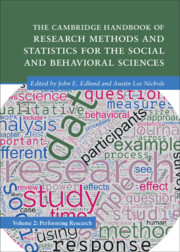1096 results

The Cambridge Handbook of Research Methods and Statistics for the Social and Behavioral Sciences
- Volume 2: Performing Research
- Coming soon
-
- Expected online publication date:
- September 2024
- Print publication:
- 30 September 2024
-
- Book
- Export citation
Lessons learned from shallow subglacial bedrock drilling campaigns in Antarctica
-
- Journal:
- Annals of Glaciology , First View
- Published online by Cambridge University Press:
- 27 March 2024, pp. 1-11
-
- Article
-
- You have access
- Open access
- HTML
- Export citation
Strategies used for the COVID-OUT decentralized trial of outpatient treatment of SARS-CoV-2
-
- Journal:
- Journal of Clinical and Translational Science / Volume 7 / Issue 1 / 2023
- Published online by Cambridge University Press:
- 07 November 2023, e242
-
- Article
-
- You have access
- Open access
- HTML
- Export citation
Contributors
-
- Book:
- The Cambridge Handbook of Research Methods and Statistics for the Social and Behavioral Sciences
- Published online:
- 25 May 2023
- Print publication:
- 08 June 2023, pp xvi-xviii
-
- Chapter
- Export citation
Figures
-
- Book:
- The Cambridge Handbook of Research Methods and Statistics for the Social and Behavioral Sciences
- Published online:
- 25 May 2023
- Print publication:
- 08 June 2023, pp x-xiii
-
- Chapter
- Export citation
Part V - Tips for a Successful Research Career
-
- Book:
- The Cambridge Handbook of Research Methods and Statistics for the Social and Behavioral Sciences
- Published online:
- 25 May 2023
- Print publication:
- 08 June 2023, pp 627-816
-
- Chapter
- Export citation
Index
-
- Book:
- The Cambridge Handbook of Research Methods and Statistics for the Social and Behavioral Sciences
- Published online:
- 25 May 2023
- Print publication:
- 08 June 2023, pp 817-842
-
- Chapter
- Export citation
Contents
-
- Book:
- The Cambridge Handbook of Research Methods and Statistics for the Social and Behavioral Sciences
- Published online:
- 25 May 2023
- Print publication:
- 08 June 2023, pp vii-ix
-
- Chapter
- Export citation
Preface
-
- Book:
- The Cambridge Handbook of Research Methods and Statistics for the Social and Behavioral Sciences
- Published online:
- 25 May 2023
- Print publication:
- 08 June 2023, pp xix-xx
-
- Chapter
- Export citation
Part II - The Building Blocks of a Study
-
- Book:
- The Cambridge Handbook of Research Methods and Statistics for the Social and Behavioral Sciences
- Published online:
- 25 May 2023
- Print publication:
- 08 June 2023, pp 177-266
-
- Chapter
- Export citation
Copyright page
-
- Book:
- The Cambridge Handbook of Research Methods and Statistics for the Social and Behavioral Sciences
- Published online:
- 25 May 2023
- Print publication:
- 08 June 2023, pp iv-iv
-
- Chapter
- Export citation
Part III - Data Collection
-
- Book:
- The Cambridge Handbook of Research Methods and Statistics for the Social and Behavioral Sciences
- Published online:
- 25 May 2023
- Print publication:
- 08 June 2023, pp 267-440
-
- Chapter
- Export citation
Appendix - Syntax in lavaan for specifying and analyzing the example path model
- from 25 - Structural Equation Modeling
-
- Book:
- The Cambridge Handbook of Research Methods and Statistics for the Social and Behavioral Sciences
- Published online:
- 25 May 2023
- Print publication:
- 08 June 2023, pp 554-558
-
- Chapter
- Export citation
Tables
-
- Book:
- The Cambridge Handbook of Research Methods and Statistics for the Social and Behavioral Sciences
- Published online:
- 25 May 2023
- Print publication:
- 08 June 2023, pp xiv-xv
-
- Chapter
- Export citation
Dedication
-
- Book:
- The Cambridge Handbook of Research Methods and Statistics for the Social and Behavioral Sciences
- Published online:
- 25 May 2023
- Print publication:
- 08 June 2023, pp v-vi
-
- Chapter
- Export citation
Part IV - Statistical Approaches
-
- Book:
- The Cambridge Handbook of Research Methods and Statistics for the Social and Behavioral Sciences
- Published online:
- 25 May 2023
- Print publication:
- 08 June 2023, pp 441-626
-
- Chapter
- Export citation
Part I - From Idea to Reality: The Basics of Research
-
- Book:
- The Cambridge Handbook of Research Methods and Statistics for the Social and Behavioral Sciences
- Published online:
- 25 May 2023
- Print publication:
- 08 June 2023, pp 1-176
-
- Chapter
- Export citation

The Cambridge Handbook of Research Methods and Statistics for the Social and Behavioral Sciences
- Volume 1: Building a Program of Research
-
- Published online:
- 25 May 2023
- Print publication:
- 08 June 2023
Evaluating the pressure dependence of PZT structures using a virtual reality environment
-
- Journal:
- Powder Diffraction / Volume 38 / Issue 2 / June 2023
- Published online by Cambridge University Press:
- 16 May 2023, pp. 90-99
-
- Article
-
- You have access
- Open access
- HTML
- Export citation
68 Metformin prevents the diagnosis of Long Covid in phase 3 trial of early treatment.
- Part of
-
- Journal:
- Journal of Clinical and Translational Science / Volume 7 / Issue s1 / April 2023
- Published online by Cambridge University Press:
- 24 April 2023, pp. 18-19
-
- Article
-
- You have access
- Open access
- Export citation



